Process, stages, Significance | Animal cells - Types of Cell Division | 9th Science : Organization of Tissues
Chapter: 9th Science : Organization of Tissues
Types of Cell Division
Types of Cell Division
The three types of cell
division that occur in animal cells are
1. Amitosis - Direct
Division
2. Mitosis - Indirect
Division
3. Meiosis - Reduction
Division
1. Amitosis
It is the simplest mode
of cell division and occurs in unicellular animals, aging cells and in foetal
membranes. During amitosis, nucleus elongates rst, and a constriction appears
in it which deepens and divides the nucleus into two, followed by this
cytoplasm divides resulting in the formation of two daughter cells.
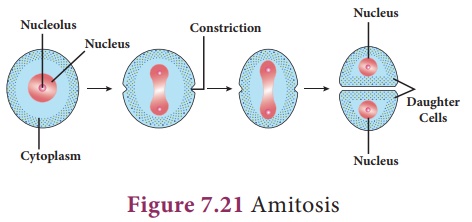
2. Mitosis
It was rst discovered by
Fleming in 1879. In this cell division one parent cell divides into two
identical daughter cells, each with a nucleus having the same amount of DNA,
same number of chromosomes and genes as the parent cells. It is also called as equational
division.
Process of Mitosis
Mitosis consists of two
events, they are
1. Karyokinesis
2. Cytokinesis
Interphase is the resting phase of
the nucleus. It is the interval between two successive cell divisions.
During this phase the cell prepares itself for the next division by
synthesizing the substances essential for next cell division.
Karyokinesis
The division of the
nucleus into two daughter nuclei is called Karyokinesis. It consists of four
phases. They are:
a. Prophase
b. Metaphase
c. Anaphase
d. Telophase
e. Cytokinesis
a. Prophase (pro-first)
During this stage
chromosomes become short and thick and are clearly visible inside the nucleus.
Centrosome splits into two daughter centrioles, they move apart and occupy
opposite poles of the cell. Each centriole is surrounded by radiating rays,
termed as aster rays. Spindle bres appear between the two centrioles. Nuclear
membrane and nucleolus disappear gradually.
b. Metaphase (meta – after)
The duplicated
chromosomes arrange on the equatorial plane and form the metaphase plate. Each
chromosome gets attached to a spindle fibre by its centromere which is known as
the chromosomal fibre. The centromere of each chromosome divides into two, each
being associated with a chromatid.
c. Anaphase (ana – up, back)
The centromeres
attaching the two chromatids divide and the two daughter chromatids of each
chromosome separate and migrate towards the two opposite poles. The migration
of the daughter chromosomes is achieved by the contraction of spindle fibres.
d. Telophase (tele – end)
Each chromatid (or)
daughter chromosome lengthens, becomes thinner and turns into a network of
chromatin threads. Spindle bres breakdown and disappear. Nuclear membrane and
nucleolus reappear in each daughter nucleus.
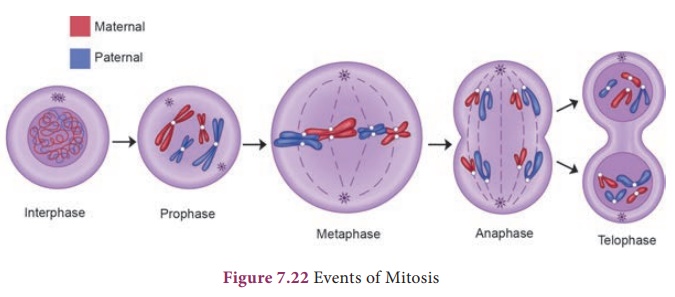
e. Cytokinesis
The division of the
cytoplasm into two daughter cells is called cytokinesis. A constriction appears
in the middle of the cell membrane, which deepens and finally divides the
cytoplasm into two, thus producing two new daughter cells from a parent cell.
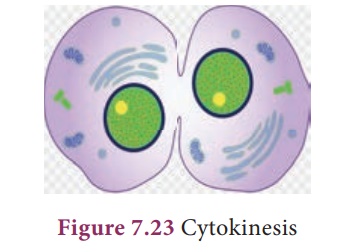
Significance of Mitosis
1. This equational division results in the production of diploid
daughter cells with equal distribution of genetic material (DNA). It maintains
the diploid (2n) number of chromosomes in daughter cells.
2. In multicellular organisms growth, organ development and
increase in body size are accomplished through the process of mitosis
3. Mitosis helps in repair of damaged and wounded tissues by
renewal of the lost cells.
4. It is involved in
replacement of old and dead cells.
3. Meiosis
The term meiosis was
coined by Farmer in 1905. It is the kind of cell division that produces the sex
cells or the gametes. It is also called reduction division because the
chromosome number is reduced to haploid from diploid (2n). Meiosis produces
four daughter cells from a parent cell.
Meiosis consists of two
divisions. They are,
A. Heterotypic
Division or First Meiotic
Division
B. Homotypic Division or Second Meiotic Division
A. Heterotypic division
It divides the diploid
cell into two haploid cells. The daughter cells resulting from this division
are different from the parent cell in the chromosome number (Heterotypic). This
consists of 5 stages.
a. Prophase I
b. Metaphase I
c. Anaphase I
d. Telophase I
e. Cytokinesis I
a. Prophase I
Prophase I takes a
longer duration and is sub divided into five stages.
1.
Leptotene
2.
Zygotene
3.
Pachytene
4.
Diplotene
5.
Diakinesis
Leptotene
The chromosomes become
uncoiled and assume long thread like structures and take up a specific
orientation inside the nucleus. They form a bouquet stage.
Zygotene (Zygon-adjoining)
Two homologous
chromosomes approach each other and begin to pair. Pairing of homologous
chromosomes is called
as synapsis.
Pachytene (Pachus-thick)
The chromosomes are
visible as long paired twisted threads. The pairs so formed are called bivalents.
Each bivalent now contains four chromatids (tetrad stage). Homologous
chromosomes of each pair begin to separate, they do not completely separate,
but remain attached together at one or more points by X- shaped arrangements
known as chiasmata. The chromatids break at these points, broken
segments maybe interchanged (crossing over). As a result, the genetic recombination
takes place.
Diplotene
Each individual
chromosome of each bivalent begins to split longitudinally into two similar
chromatids. The homologous chromosomes repel each other and separate. Chiasmata
begin to move along the length of the chromosome from the centromere towards
the end resulting in terminalization.
Diakinesis
The paired chromosomes are
shortened and thickened. The nuclear membrane and nucleolus begin to disappear.
Spindle fibres make their appearance.
b. Metaphase I
The chromosomes move
towards the equator and finally they orient themselves on the equator. The two
chromatids of each chromosome do not separate as in Mitosis. The centromere
does not divide.
c. Anaphase I
Each homologous
chromosome with its two chromatids and undivided centromere move towards the
opposite poles of the cell. This stage of the chromosome is called Diad.
d. Telophase I
The haploid number of
chromosomes after reaching their respective poles become uncoiled and
elongated. The nuclear membrane and the nucleolus reappear and thus two
daughter nuclei are formed.
e. Cytokinesis I
The cytoplasmic division
occurs and two haploid cells are formed.
B. Homotypic Division
In this division, the
two haploid cells formed during first meiotic division divide into four haploid
cells. The daughter cells are similar to parent cell in the chromosome number
(Homotypic). It consists of five stages.
a. Prophase – II
b. Metaphase – II
c. Anaphase – II
d. Telophase – II
e. Cytokinesis – II
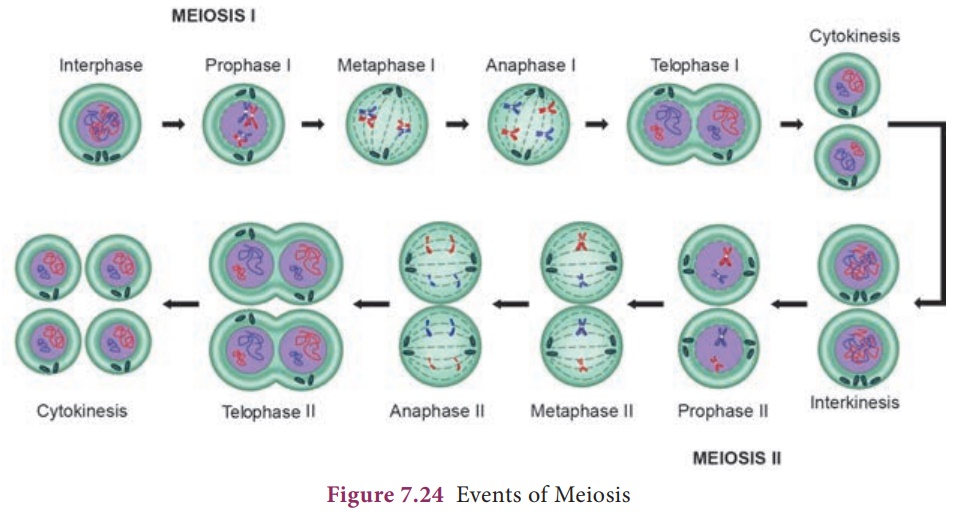
a. Prophase II
The centriole divides
into two, each one moves to opposite poles. Asters and spindle fibres appear.
Nuclear membrane and nucleolus disappear.
b. Metaphase – II
The chromosomes get
arranged on the
equator. Two chromatids
are separated.
c. Anaphase - II
The separated chromatids
become daughter chromosomes and move to opposite poles due to the contraction
of the spindle fibres.
d. Telophase – II
The daughter chromosomes
are centered. The nuclear membrane and the nucleolus appear.
e. Cytokinesis – II
It occurs after nuclear
division and two cells are formed from each haploid daughter cell, resulting in
the formation of four cells with haploid number of chromosomes.
Significance of Meiosis
i. The constant number of chromosomes in a given species is
maintained by meiotic division.
ii. Crossing over causes genetic variations among the species from one generation to the next.
Differences between Mitosis and Meiosis
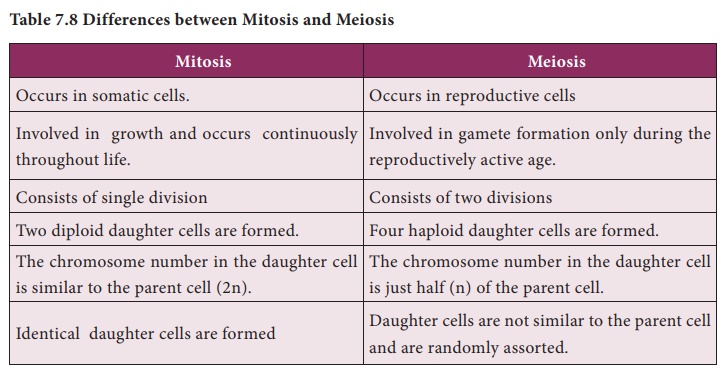
Mitosis
·
Occurs
in somatic cells.
·
Involved
in growth and occurs continuously throughout life.
·
Consists
of single division
·
Two
diploid daughter cells are formed.
·
The
chromosome number in the daughter cell is similar to the parent cell (2n).
·
Identical
daughter cells are formed
Meiosis
·
Occurs
in reproductive cells
·
Involved
in gamete formation only during the reproductively active age.
·
Consists
of two divisions
·
Four
haploid daughter cells are formed.
·
The
chromosome number in the daughter cell is just half (n) of the parent cell.
·
Daughter
cells are not similar to the parent cell and are randomly assorted.
Related Topics